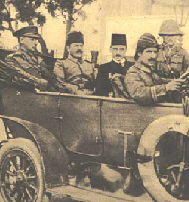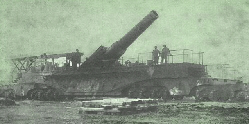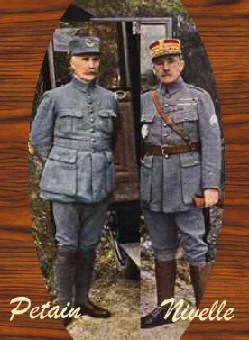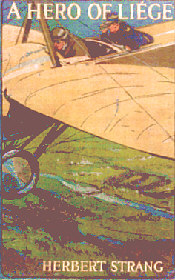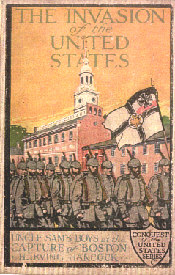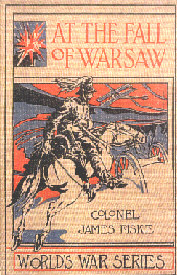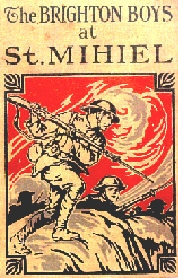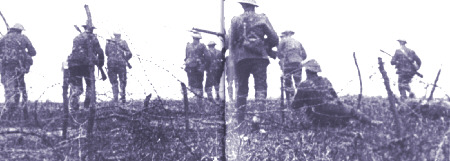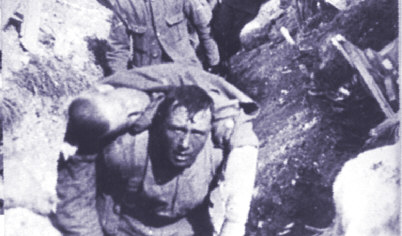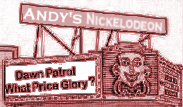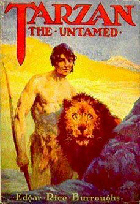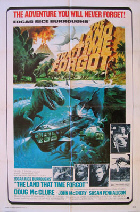
April 2006 |
Access Archives |
TRENCH REPORT: It's Baseball Season so it's time for Baseball News: The Curse of Capt. Eddie [Grant], the inability of the San Francisco Giants to win a world series since their loss of the memorial plaque honoring the former Giant killed in action in the Argonne Forest--first identified in these pages [the Curse that is]--continues to attract attention and press coverage. It's name has morphed, however, into the Plague of the Plaque.
(article) We will defer to the higher journalistic powers and adopt that name for the Capt. Eddie Phenomena in the future. . .Chateau Thierry author David Homsher's site on the American Expeditionary Force is now fully operational. Please check it out. (link). . .For those who have been following the saga, on March 31st it was settled that I will have NO further involvement in either the seminars or journal of the Great War Society. Thanks to those who have sent encouragement and support, but life goes on.
MH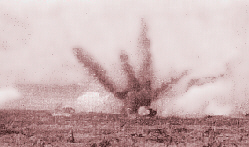 Direct Artillery Hit on Mark IV TankWikipedia and the Great War Some of you were SHOCKED & APPALLED last month when I recommended AJP Taylor's biography from the much-maligned Wikipedia on-line encyclopedia. My WWI experiences on Wikipedia have been uniformly outstanding. Some samples of what I'm talking about are listed below. If any of the authors of these articles are out there in reader land, please contact me. (email) 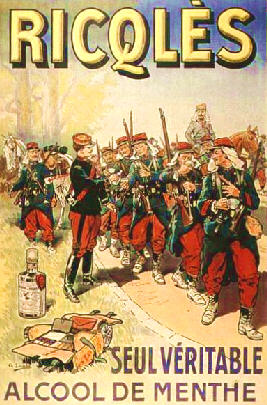 French Advertisement
  A GWS Mousepad for the First Person Who Identifies the Designer. (email) |
April 25th is ANZAC Day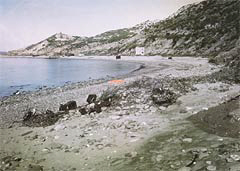
ANZAC Cove Today
|
||||||||||||||||||
GREAT WAR 2006 EVENT CALENDAR | |
|
90th Commemorative Events Comprehensive Double Calendar Scheduled Throughout 2006 (link) | |
|
Baltimore, MD April 1 (link) | |
|
Popular Culture Newcastle Inst. for the Arts & Social Sciences March 31 - Apr. 2 (link) | |
|
King's Chapel, Boston Music of Charles Martin Loeffler April 25th, 12:15pm (directions) | |
|
Aurora, Colorado May 19-21 (link) | |
|
Hilton Garden Inn, Tampa North August 16 (link) | |
|
Email Response |
|
|
Art Critic Robert Hughes has just published an essay inspired by a new show at London's Victoria and Albert Museum on Modernism. He ties it directly [along with Futurism and Dadaism] to the First World War (link). . .World War One Aviation will be the subject of a special event to be hosted by The Air Museum ‘Planes of Fame’ at the Chino Airport on Saturday, May 6, 2006. The event will begin at 10am with a seminar on the role of aviation in the First World War and conclude with the flight demonstration of a ‘Planes of Fame’ warbird. . .War Poetry Contest. The Winning Writers website announces its annual competition. Top prize is $1,500. (link). . .For our friends in Greenville, South Carolina - your local library is sponsoring a WWI documentary series (link).

I spat and swung the gun around. Fired,
felt the metal pulse
and laid them three deep in the wire.
From: The Machine Gunner
by Steven Heighton, 1994
<<< Winner In!
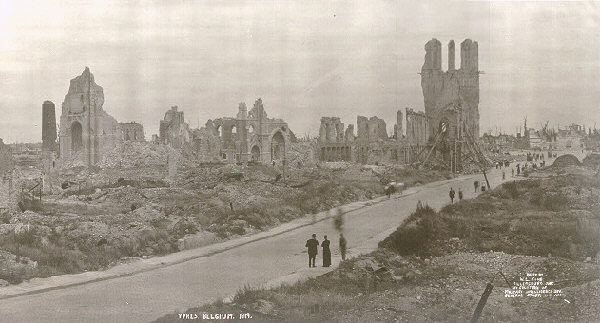
Tourists Visiting Ypres, 1919
We have received announcements of the passing of two more World War I notables:
Trevor Wilson on ANZAC Day
(Found at the ABC Website)
Why are Australians so concerned about Anzac Day?
 Prof. Wilson |
So there were these very strong feelings for so many Australians who were in fact recent migrants from Britain, or their parents certainly were. If you looked at the AIF most of them are either first generation British or their parents are first generation British so that there was this enormous association between Britain and its colonies, its white colonies anyway.
So do you see the First World War as being really Australians seeing themselves as an outpost of Britain going back there?
Yes.
What about this idea that the nation was founded then? Do you agree with that idea?
 |
There was a sense that Australia was a great power because it was part of the Empire. It's manifestly not a great power in its own right. It's a very little power and if the rest of the world turns hostile against it and if the British Navy and the British power was not there to protect it, it was going to be in a very precarious situation.
|
Verdun |
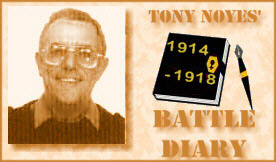 |
The Somme | |
Eventually, northwest of Verdun, the sheer weight of the German infantry assaults and of their massive shelling carried them to the tops of both Mort Homme and Hill 304.Click Here to See a Large
|
Initially Britain was not organized for a major continental war, nor for this almighty influx of civilians, each one clamouring to be a soldier. Very old retired officers besieged the War Office demanding employment, recalling their services with the Colours in Africa and the Empire, back in '84, or even back at Balaclava!
Click Here to See a Large Battlefield Map of the SommeOften, anyone who had held any position of authority anywhere whether in the Boy Scouts or the accounts office, was invited to step forward and told, "You are now in charge of this group of men." Accommodation was problematic and initially the men went home at the end of the day. Barracks came much later! Drill was the order of the day and gradually the men learned to form fours, right turn and to step off smartly with the LEFT foot all in accordance with the requirements of the drill manual and more importantly, the commands of the stentorian voice of the drill sergeant. In the spring of 1915, army uniforms began to arrive, and, later, rifles, albeit not the latest Short Magazine Lee Enfields. Now the men of the New Armies, as they were called, were beginning to look like soldiers! They rapidly had their photos taken with unofficial watch chains, swagger canes in hand and a girl friend on their arm. Through the summer of 1915 they became a trained body of men, polishing their new barrack blocks and taking a pride in their new found house cleaning abilities, fired musketry courses and drilled. They learned to put a penny in the magazine of their Lee-Enfield rifles so that the crash of rifle drill echoed across the windblown barrack squares. And one unit at a time, they were judged to be soldiers and sent to France. The great adventure had begun. |
||
If you would like to visit these fields of memory for a detailed tour, please email Tony Noyes or Christina Holstein to discuss your requirements without obligation. |
|||

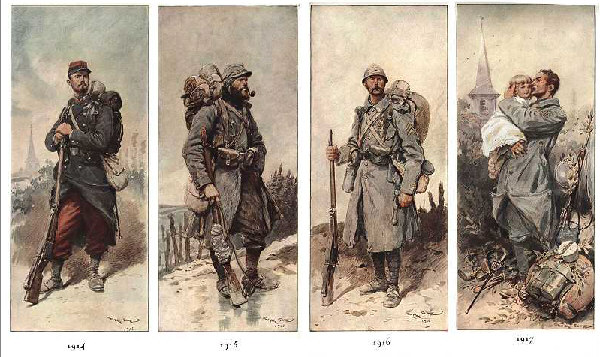
French Illustrator Georges Scott Depicts the Poilu
 |
The Ossuary
At Verdun
By Christina Holstein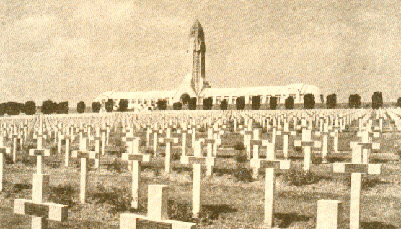
The Ossuary was inaugurated on 7 August 1932 and owes its origin
to the work of Monsignor Ginisty, Archbishop of Verdun from 1914 to
1946, who travelled the world to raise money to build a final resting
place for the men whose bones scattered the battlefield. The building
is said to represent the hilt’ of a sword that has been thrust into the
ground against the invader.
Inside the Ossuary, the central gallery is 137 metres long and
houses forty six stone ‘coffins’ set in alcoves. Each alcove
commemorates a particular sector of the battlefield and any human
remains found in that sector are placed in the corresponding vault on
the lower floor. The Douaumont alcove is immediately on the right of
the chapel by the entrance to the tower. At the top of the tower,
orientation tables in the window ledges help to identify the principal
features of the battlefield. Although Fort Douaumont is only just
visible from the tower, the extensive panorama brings out clearly the
strategic importance of the Douaumont-Froideterre Ridge.
The chapel has an interesting series of memorial windows. The first
window on the right and the last window on the left are memorials to
Lieutenant Francois Guéneau de Mussy, the commander of 8 Company,
129th Infantry, who was killed on Fort Douaumont on 22 May 1916. The
last window before the altar on the right hand side is an unusual memorial
to nurses who served at Verdun. Mass is said in the chapel at 10am on the
first Sunday of each month. The national cemetery in front of the Ossuary
contains the graves of 15,000 French soldiers, a section on the left hand
side being dedicated to Muslim soldiers in French regiments.
Text by Permission from Christina's book Fort Douaumont hereby recommended. (order)
|
in the 21st Century |
|

|
Help for Genealogical Researchers |
Ancestry Magazine is published by monthly by Myfamily.com. The magazine contains articles by and for genealogists. The November/December 2005 issue (Vol. 23 No. 6) features tips for research related to World War I. Under the umbrella title of "Bringing WWI to Light", a series of articles discuss public records and other resources:
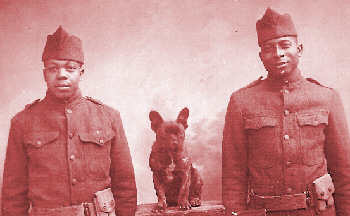
Two American Doughboys with Friend
- "Answers in the Trenches: Finding Family History in World War I" is a short overview of the war.
- "Smoldering Home Fires" discusses how census records and alien registration records were gathered and which alien registration records have survived.
- "Fighting to Become American" covers military naturalization
- "Searching the Home Front" gives information on research using service records, draft records, discharge papers, cemetery and death records and the effects of the Great War on records abroad.
- "Memoirs and Memories" is a list of web sites that contain first-hand accounts of World War I experiences.
Unfortunately, only two Tarzan films have been produced as period pieces, Greystoke: The Legend of Tarzan, Lord of the Apes and Tarzan and the Lost City. Tarzan: The Epic Adventures television series starring Joe Lara aired in 1996-1997. Many of the episodes were more directly based on the Tarzan novels than previous incarnations but this series isn't scheduled for DVD release. Bob Clampett tried animating John Carter of Mars but couldn't get financial backing. His animation tests can be found on the now out of print DVD, Bob Clampett's: Beany and Cecil. A feature film based on John Carter of Mars is currently in pre-production. Beyond Thirty (recently republished by the University of Nebraska Press in their Bison Frontiers of Imagination series) takes place in the year 2137 and deals with the adventures of the crew of a Pan-American Federation aero-sub who accidentally make contact with the Old World after a century and half of isolation. Burroughs saw a future where the First World War shattered the Old World empires that sunk to barbarism and new empires of China and Africa emerged. 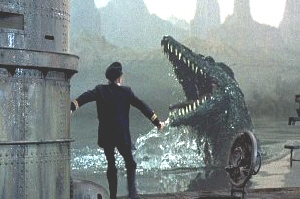 German U-Boat Meets Unanticipated DangerThe Land That Time Forgot directed by Kevin Connor and starring Doug McClure was released in 1975. The screenplay was co-written by noted science-fiction writer Michael Moorcock. It follows the basic plot of the novel with a World War One German U-Boat and the survivors of a torpedoed British freighter combining their forces and wits to survive lots of dinosaurs and cavemen. Unfortunately, while the first half hour is a good sea war adventure story, the mediocre special effects used to create the prehistoric animals nearly sink the picture in the last hour. However, there's a whole prehistoric menagerie on display with nine different species to be seen- a Pterodactyl, Mosasaurus, Plesiosaurus, Diplodocus, Allosaurus, Ceratosaurus, Triceratops, Styracosaurus and a Polacanthus. There may not be quality but there is quantity and Caprona looks prehistoric with lush vegetation, oozing pools of oil, mists and the occasional prehistoric landscape panorama.
The Land That Time Forgot and The People That Time Forgot are available on DVD as a Midnite Movies Double Feature from MGM Home Entertainment. Both titles are enhanced 16X9 widescreen which shows off their good points of production design, location footage and volcanic eruptions and their bad points. Andrew Melomet, Proprietor of Andy's Nickelodeon will answer your Great War film or video inquiry. He is also soliciting your recommendations for the WWI Filmography he is compiling for our readers. Just click HERE. |
| The following are thanked for their contributions to this issue of the Trip Wire:Donna Cunningham, Christina Holstein, Bob Denison, Bob Ford, Tony Noyes, Esther MacCallum-Stewart, Andy Melomet, Len Shurtleff. [Sorry I lost the full list for this issue.] Until next month, your editor, Mike Hanlon. |
Membership Information  Click on Icon |
SUBSCRIBE TO THE TRIP-WIRE (Or Send it to a friend.) (Or send us a comment on the TRIP-WIRE) CLICK HERE TO CONTACT US VIA EMAIL |
For further information on the events of 1914-1918
visit the Directory Page of |

